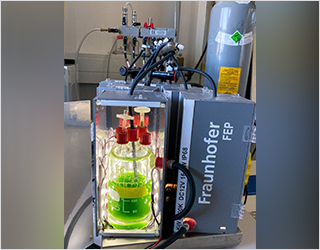Development of living building materials of the future through carbon dioxide uptake and carbonate mineralization by phototrophic microorganisms

In the SME project BioCarboBeton, a process for biogenic material production through carbonate mineralization was developed using phototrophic microorganisms to produce a novel climate-neutral building and construction material..
Concrete is probably the most widely used building material of our time due to its versatile application possibilities. With the global population growth, urbanization, and increasing infrastructure development, the global demand for the main component of concrete, cement, is estimated to increase by 12 – 23% by 2050. Cement production alone contributes to an annual carbon dioxide emission of more than 20 million tons in Germany. With the efforts of the federal government to achieve complete climate neutrality by 2045, the cement industry is facing an enormous challenge. Climate neutrality in this area can only be achieved through alternative approaches such as the use of renewable raw materials or the recycling of cement.
Another approach is pursued by the Fraunhofer internal SME project BioCarboBeton through the development and specific shaping of Living Building Materials – »Living Building Materials« (LBM) in collaboration with Fraunhofer IKTS. The focus of the project work in the Medical and Biotechnological Applications division of Fraunhofer FEP is the biogenic material development of secondary lime (biomineralization), including complementary analytical process monitoring and microbiological evaluation, as well as the optimization and scalability of the biomineralization process to address large-scale application possibilities.
The production of a living building material aims to achieve targeted uptake of atmospheric or industrial carbon dioxide with subsequent conversion into calcium carbonate as secondary lime. This process of carbonate mineralization is induced by phototrophic microorganisms (cyanobacteria) embedded in a special (bio)polymer composite matrix with mineral aggregates, contributing to the creation of a mechanically stable and future-oriented building material. Unlike conventional materials, it is based on a climate-neutral production process, is recyclable, and can reduce environmental impact by using waste from other industries. By establishing a new cultivation system and regulating individual microbial growth parameters, an increase in biomass productivity and the ability to biomineralize has already been achieved.
 Fraunhofer Institute for Electron Beam
Fraunhofer Institute for Electron Beam